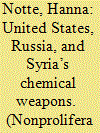|
|
|
Sort Order |
|
|
|
Items / Page
|
|
|
|
|
|
|
| Srl | Item |
| 1 |
ID:
146063


|
|
|
|
|
| Summary/Abstract |
In recent months, as Russia has stepped up its involvement in the Syrian civil war, there has been a flurry of analysis by Western observers of Moscow's possible objectives. On a spectrum of interpretations concerning Russian actions are claims that the Kremlin's main concern is ensuring the survival of the Assad regime. Others assume broader strategic foreign-policy goals, including no less than a “grand bargain” with the West over the Ukraine crisis and Moscow's re-admission into the club of Western nations.
|
|
|
|
|
|
|
|
|
|
|
|
|
|
|
|
| 2 |
ID:
187491


|
|
|
|
|
| Summary/Abstract |
This article identifies the principal drivers of Russian military innovation involving five novel nuclear, conventional, or dual-capable delivery systems—Avangard, Burevestnik, Poseidon, Kinzhal, and Tsirkon—and analyzes the interplay between these drivers over the course of the innovation process. It does so by means of a structured, focused comparison of the five systems and their progression to date, distinguishing “innovation” from concepts like “invention” and “diffusion,” and defining the stages of an innovation life cycle. The article also distills prior research on Soviet weapons innovation and investigates its continued validity. The analysis finds external factors to be central in driving innovation, specifically Russian threat perceptions around (1) US missile-defense development and (2) the development of Western conventional warfighting capabilities. It also discusses the roles of a range of internal factors, including industry and high-level political support for specific systems, the availability of Soviet-legacy research and engineering initiatives, and the appeal of anticipated industrial and ancillary benefits from the development of specific systems. Cooperation between design bureaus and other industry players is also examined, as is the role of status considerations in driving innovation. Finally, the relative importance of individual factors in explaining innovation is shown to differ across the systems. The structured comparison identifies the continued validity of certain aspects of past studies on Soviet military innovation, while also bringing to light new insights about contemporary Russian weapons innovation.
|
|
|
|
|
|
|
|
|
|
|
|
|
|
|
|
| 3 |
ID:
182648


|
|
|
|
|
| Summary/Abstract |
This article analyzes the drivers of US–Russian cooperation in the disarmament of Syria’s declared chemical weapons (CW) in 2013–14, emphasizing the primary importance of credible coercion vis-à-vis the Syrian government. It identifies additional significant drivers—including the resonance of institutional memory of cooperation through the Cooperative Threat Reduction (CTR) programs; continued interest alignment for Russia through consensus on a hybrid disarmament framework; and constructive relationships among senior officials on both sides—while also showing the relevance of Russian sensitivities to status, the prospects of a new round of Syria peace talks planned at the time (“Geneva II”), and expectations of positive “spillover” from narrow cooperation on Syrian CW into other areas of US–Russian relations. The article further traces and explains the unravelling of internal consensus within the Organisation for the Prohibition of Chemical Weapons (OPCW) on the Syrian CW file between 2014 and the present day, analyzing growing frictions over the Fact-Finding Mission, the Joint Investigative Mechanism, and the Investigation and Identification Team. Disagreements within the OPCW over these issues became increasingly viewed as inextricably linked to the broader geopolitical Russia–West confrontation. Finally, the article probes the resultant implications for prospects of universalizing the 1993 Chemical Weapons Convention and making progress toward a weapons-of-mass-destruction-free zone in the Middle East.
|
|
|
|
|
|
|
|
|
|
|
|
|
|
|
|
|
|
|
|
|